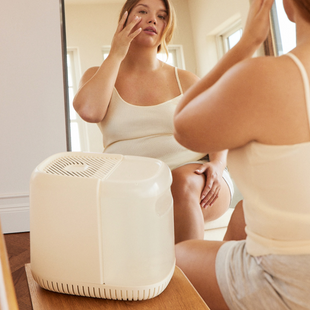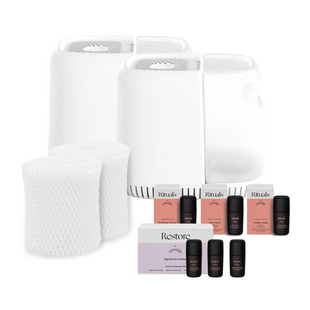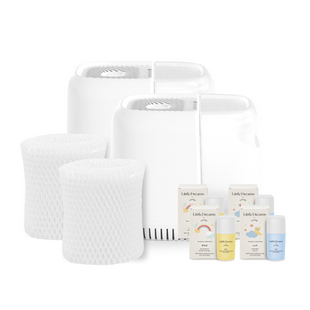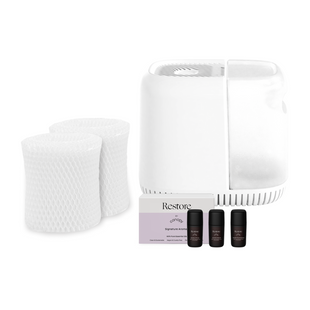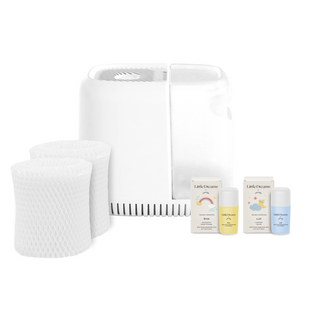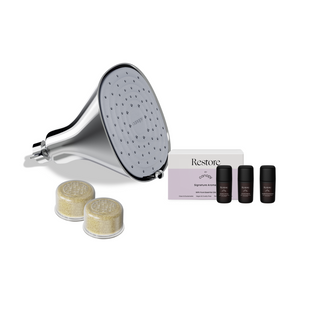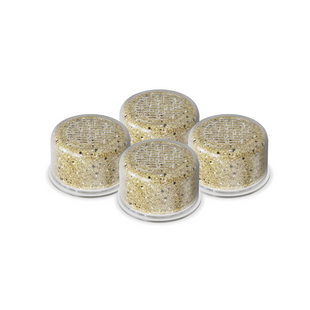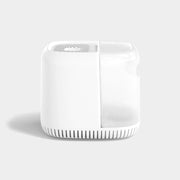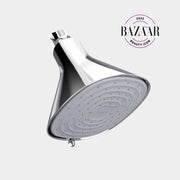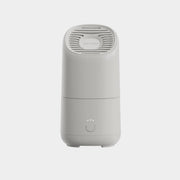During cold and flu season, you’ll do anything to avoid getting sick—and if you do catch something, you’ll do anything to reduce the uncomfortable symptoms. While we can’t overemphasize the importance of getting plenty of rest, drinking fluids, and making an appointment with your doctor when your symptoms linger or get worse, there are some things you can do on your own to feel better.
Canopy is here to help during the colder months when the air dries out, and germs seem to run rampant. We build humidifiers that make life more comfortable, even when it’s cold and flu season. If you find yourself sneezing and sniffling and wondering, “When is cold and flu season going to be over,” this guide is for you.
Why Canopy Cares About Cold & Flu Season
Canopy was founded to help promote wellness at home. Indoor humidity plays a significant role in how you look and feel, so we created a line of products to help add moisture that helps to help you breathe easier, sleep better, and maintain a healthier routine. Here’s how:
- Improving Indoor Humidity: Dry air can support the spread of the viruses that cause illness, whether it’s the common cold, a seasonal flu strain, or COVID-19. Maintaining the ideal humidity level of about 40% to 60% reduces the survival rate of the viruses that cause winter illnesses, reducing your risk of getting sick.
- Promoting Clean, Safe Air: Unlike warm mist devices that can generate heat or increase the potential for mold growth, Canopy Humidifiers use ultrasonic technology to create a cool vapor, eliminating the risk of excess dampness and mold spores.
- Releasing Clean Moisture: Even when you use filtered or distilled water, the vapor from other humidifiers may contain heavy metals, bacteria, and minerals that can worsen your symptoms. Canopy Humidifiers use unique paper filters to remove contaminants from water before the ultrasonic technology turns it into mist. You enjoy clean moisture that won’t cause additional problems—even if you use regular tap water.
Aromatherapy the Canopy Way

Using a Canopy Humidifier for colds and the flu also allows you to take advantage of aromatherapy to ease your symptoms and encourage relaxation.
Scents like eucalyptus and peppermint can help relieve congestion, enabling you to breathe more easily. Lavender is a relaxing scent that supports better sleep. Getting plenty of rest is a great way to avoid getting sick during the cold and flu season and help you recover from illnesses sooner.
Managing Cold and Flu Symptoms With a Humidifier
Everyone has had a cold at some point and knows how miserable a stuffy nose, cough, and sore throat can be. These symptoms often worsen at night and disrupt sleep, leaving you tired on top of everything else. The good news? Our Bedside Humidifier puts comfort and relief right at your fingertips.
Research shows that using a humidifier for flu and cold symptoms can help make you more comfortable. Here are a few ways this household device can benefit you during the season:
- Helps Alleviate Congestion: Dry air increases irritation in the sinuses and airways, which can spur your body to produce more mucus and congestion. Adding moisture to the air reduces this irritation and mucus, relieving your stuffy nose and making coughing easier.
- Soothes Dry Nasal Passages: Even if you don’t have a cold, using a humidifier helps combat dry air’s effects on your sinuses and nose.
- Relieves Respiratory Conditions: A humidifier can also help reduce the symptoms of common winter ailments, like bronchitis and laryngitis, by preventing the dry airways that exacerbate symptoms.
Eliminate Dry Air for Your Comfort & Well-Being
When the temperature drops outside, so does the moisture in the air. In fact, in some homes, indoor humidity can drop as low as 10%. Not only does this allow germs to spread, but it also feels stuffy and uncomfortable. If you’ve ever wondered why you feel like you’re coming down with something more often than you actually get sick, this is often why.
Using a Canopy Humidifier adds just enough moisture to the environment to maintain an ideal humidity level of 40% to 60%. It can protect your health and belongings and allow you to enjoy the season without common discomforts. Adding humidity can also help your home feel warm and cozy, no matter the weather, since moisture can help spaces feel several degrees warmer. Running a humidifier can also help counteract the drying effects of a furnace or steam radiator, which can dry air when it produces heat.
New York City apartment buildings are prime examples. They get heat from outdated central boilers connecting to each unit's radiator. The radiator steam leaves apartments overheated, and the heat causes the relative humidity to drop.
Old houses can be just as dry as NYC apartments when cold, dry air seeps in through gaps and cracks in the structure.
How Canopy Helps Make Cold & Flu Season More Manageable
When is cold and flu season? It runs longer than you might expect: The uptick in flu virus activity starts in October and stays elevated from December through February. As we’ve learned over the last few years, COVID-19 transmission can also increase during this time, and new variants may appear based on human activities.
Numerous factors influence why people get cold and flu symptoms and respiratory problems during fall and winter:
- Spending more time in crowds, from holiday shopping to family parties
- Staying indoors in a dry environment
- Dry air allowing viruses to flourish

Balancing Indoor Humidity for More Comfortable Breathing
Using a Canopy device is one way to actively control cold and flu symptoms. Our Bedside Humidifier is designed for spaces up to 500 square feet, while the Humidifier Plus hydrates spaces up to 1,000 square feet. The built-in sensors and auto mode keep indoor humidity levels between the recommended 40% and 60%.
This range might be surprising, but this much moisture in the air dramatically reduces allergen and contaminant circulation, reducing respiratory symptoms that tend to increase during the fall and winter. The humidifier’s water vapor makes particles too heavy to remain airborne and spread quickly, keeping them out of your airways.
Relieving Dry Sinuses & Throat
Breathing in dry air robs your nasal passages and throat of moisture, which can cause nosebleeds and sore throats. Mucus helps trap germs and viruses, but dry air affects how long it takes for mucus to leave the body. In the meantime, viruses can pull apart from the mucus and make you sick. Dry air also causes the mucus to thicken, which can cause sinus pressure.
A humidifier for sinus pressure and dryness can provide relief. The water vapor keeps airways and nasal passages moist and the mucus lining thin for more comfortable breathing.
Soothing Bronchitis & Laryngitis Symptoms
A cold or respiratory virus can cause bronchitis. This respiratory infection could be behind your sore throat and congestion. When the air is dry, bronchial tubes can't stay hydrated. This can cause asthma attacks and allergy flare-ups on top of already being sick. Running a humidifier for colds and respiratory infections can alleviate these symptoms.
Like bronchitis, laryngitis causes frequent coughing and throat dryness. A humidifier can also keep mucus membranes and airways moist.
How Cold & Flu Season Affects Babies & Children

Parents can expect their infants to catch colds as their immune systems strengthen, even when it’s not an active cold and flu season. Many cold symptoms are the same in infants and adults:
- Runny nose
- Coughing
- Fever
- Sneezing
These symptoms, accompanied by diarrhea and vomiting, could be signs of the flu.
Since babies can’t explain how they feel before symptoms fully emerge, pay attention to changes in your little one’s behavior. They might cry more often or seem more squeamish than usual when they’re not feeling well.
Young kids aren’t immune from getting sick during cold and flu season. The influenza virus can spread particularly fast among this age group since kids aren’t always mindful of covering their noses and mouths when coughing and sneezing. This is how virus droplets move from child to child and land on shared surfaces at home and in classrooms.
Follow your pediatrician’s guidance and run a humidifier for flu and cold to help reduce the severity of your little one’s symptoms. Breathing in the moisture thins excess mucus, which relieves coughing and congestion.
When shopping for a humidifier, choose a cool mist system over a warm mist one for hydrating the areas your kids have access to. Cool mist humidifiers are safer for use around kids because they don’t generate or release heat.
Aromatherapy for Comfort & Sleep
Nasal congestion, coughing, sinus pressure, and other cold or flu symptoms can make it difficult to sleep through the night. The lack of sleep can make you feel groggy and irritable, in addition to being sick.
Aromatherapy can combat sleep issues and make you more comfortable while fighting a cold or the flu. Smelling the fragrances of specific essential oils can provide numerous therapeutic benefits:
- Eucalyptus essential oil and the menthol in peppermint oil help unblock clogged nasal passages
- Citrusy bergamot is an energizing fragrance, and the oil has antiviral benefits to keep the flu virus from circulating
- Lavender is a soothing scent that lowers blood pressure and heart rate, encouraging more restful sleep
- Chamomile essential oil prompts the brainstem to release serotonin, a neurotransmitter and effective sleep aid
You’ll find these essential oils and other enticing fragrance blends in our aroma kits.
Caring for Your Canopy Humidifier

Taking care of your humidifier is necessary to keep it running smoothly. Most devices require distilled water, which doesn’t contain the high mineral content that can damage your internal components.
Luckily, the Canopy Humidifiers don’t have this type of requirement. You can use water straight out of the tap because the paper filter captures impurities before the vapor can release them into the air. Our humidifier also uses UV light to curb mold and bacteria growth that could otherwise set off cold and flu symptoms.
Taking care of your humidifier only calls for a few simple steps:
- Change your humidifier filter at least every 5 to 7 weeks: Minerals collect on the filter quickly, so change it more often if you have hard water. Watch for the Filter light on your humidifier and swap the used one for a new one. Hold the On/Off button for 30 seconds to reset.
- Stock up on new filters: Choose a multi-filter bundle or a convenient subscription to ensure you always have clean, fresh replacement filters available. When you sign up for a subscription, we’ll send reminders when your shipping date is coming up.
- Clean the components: Routinely clean the cap, tank, and tray to prevent germ and bacteria buildup and keep the humidifier looking brand new. For your convenience, these components are dishwasher safe—but wipe down the body of the humidifier by hand to protect the mechanical parts.
Thoughtful Solutions for Cold & Flu Season
You can’t predict when you’ll get sick during cold and flu season, but Canopy is here to help you say goodbye to uncomfortable respiratory symptoms and restless nights. Our entire humidifier collection is designed with mold-inhibiting technology and up to 36 hours of runtime between tank refills. We also make clean-up a breeze so you can spend more time taking care of yourself and your loved ones, all while enjoying fresh, hydrated air and fragrances that make any space feel more like home.

